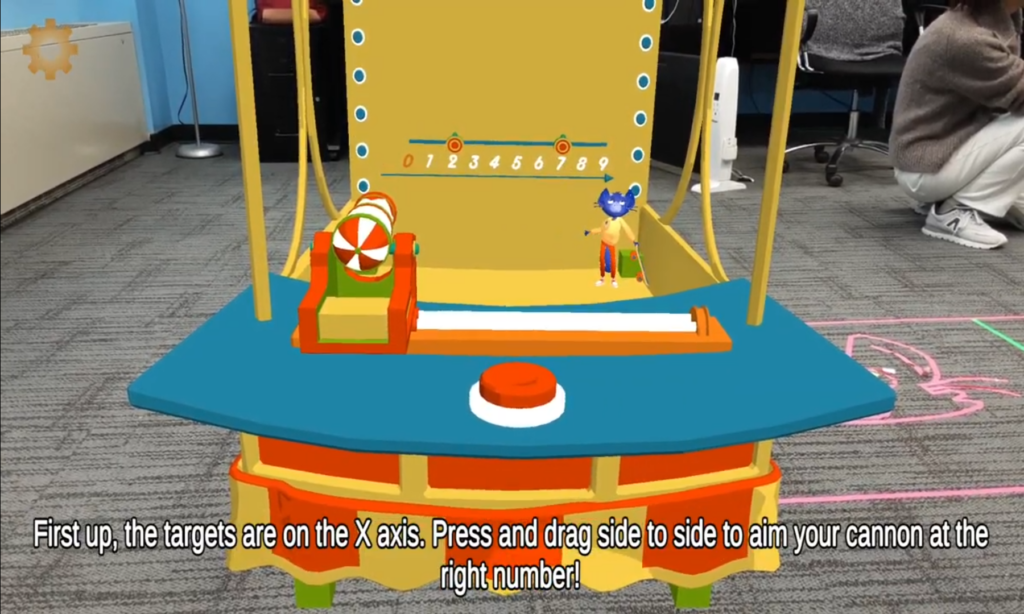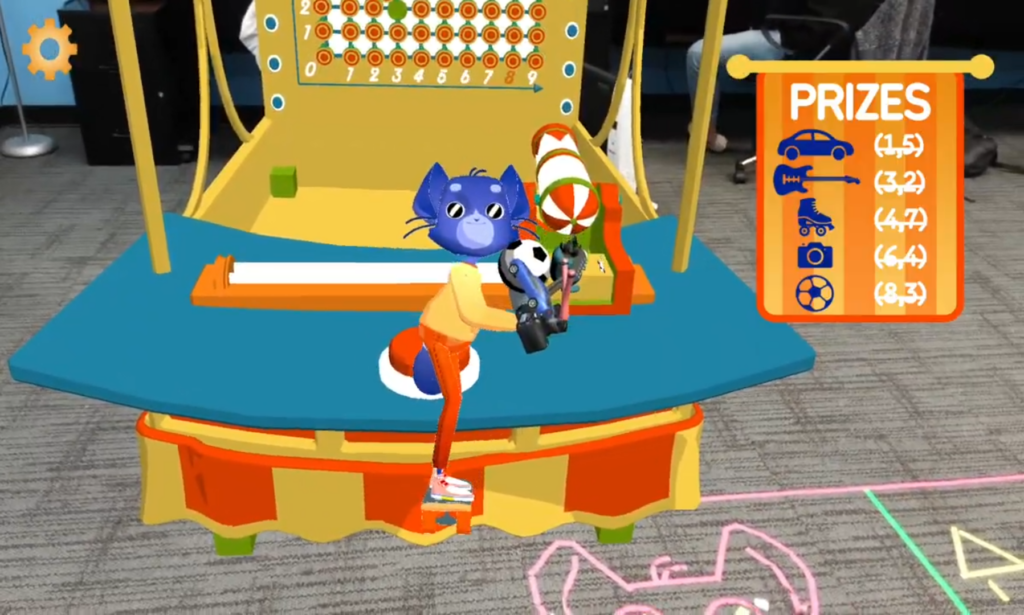The Carnival
In this activity, students will play with virtual water balloons at Finley’s Cartesian Carnival. By aiming their water balloon cannon along the two coordinate axes and the coordinate plane, they’ll practice graphing points in the first quadrant.
Why use the Carnival activity?
The Carnival presents the coordinate plane in a fun and motivating way for students just starting to learn about graphing points in two dimensions. While it is not intended as an introduction to the concept, the information is scaffolded in such a way that students who have not mastered graphing points in two dimensions can still enjoy the activity.
In particular, our activity covers the directionality of the X and Y axes, the (x, y) order in an ordered pair, and how to graph a point from its ordered pair by finding its position on the X and then Y axes. It visualizes the coordinate plane as a backdrop for a carnival game, and the points to be graphed as targets for water balloon throwing. The physical action of repositioning the cannon provides a way to visualize different points’ relationship to each other in the X and Y directions.
Our activity provides instant positive feedback in the form of virtual prizes behind the water balloon targets, but does not contain any negative feedback if the students graph a point incorrectly. They have an infinite number of tries available to get it right, reducing anxiety and allowing for moments of play with the water balloons and our character Finley. Our student playtesters have felt that this activity gives them opportunities for fun. Much like the other activities, the Carnival provides an opportunity to play with math in three dimensions and enjoy a break from pencil and paper activities.
What’s in the activity?
The Carnival activity shows students each step of what they would need to graph points in the first quadrant of the coordinate plane, through the metaphor of firing water balloons from a cannon to hit targets. At each step, once students demonstrate understanding of the mechanics by winning all the prizes in that phase of the activity, they will move on to the next phase.
1. First, the students are presented with a horizontal number line, called the X-axis in the activity, and several targets along the axis. To move the cannon into position to hit the targets, they must press and drag left or right on the cannon. Each time they press and drag, the cannon will move over in increments of 1 in the indicated direction, as indicated by the number on the axis changing color. The edges of the number line are 0 and 9, and the cannon cannot move farther than these points at any point during the activity. To fire a water balloon from the cannon, the students should press the button. The students have infinite water balloons at all points in the activity, so no need for them to hit the target on the first try.
Math Concept: Finding points on the horizontal number line, naming the horizontal number line as the X-axis.
Math Question, before starting: How do you know how far away two points on the number line are?
Math Question, after tossing balloons along the X Axis: Which point on the X Axis had your favorite prize?

2. Then, the students are introduced to the Y-axis, a vertical number line. To hit points on the Y axis, they must press and drag up and down to position the cannon vertically. Just like horizontal movement, the cannon will move in increments of 1 with each press and drag, and the number on the Y-axis will also change color when the cannon points at it. The bounds of the Y-axis are 0 and 9.
Math Concept: Finding points on the vertical number line, naming the vertical number line as the Y-axis.
Math Question, before tossing balloons on the Y Axis: Why do you think the targets are on a vertical line now?
Math Question, after tossing balloons on the Y Axis: What’s the same about the X axis and the Y axis? What’s different about them?

3. Now, both the X and Y axis are visible, as well as the first quadrant of the coordinate plane between (0,0) and (9,9). There are targets throughout the coordinate plane, which are labeled with the ordered pair. In order to hit the targets, the students must read the ordered pairs and position the cannon correctly along both the X and Y axes. The number on each axis changes color when the cannon is in that position. For example, if the cannon was pointed at (2, 3), then the label 2 on the X-axis and 3 on the Y-axis would be highlighted.
Math Concept: Graphing points in the first quadrant based on their ordered pairs, the spatial relationship between an ordered pair, and position along the axes.
Math Question, before tossing to ordered pairs: How would you get the cannon to point at a target that was above the X axis?
Math Question, after tossing to ordered pairs: When you wanted to move the cannon from one ordered pair to another, how did you do it?

4. Finally, the toughest challenge presents the students with many targets, spread around evenly in the coordinate plane. None of these targets are labeled with their ordered pairs. Additionally, there are only a few which have prizes behind them. To help students figure out which targets have prizes, the ordered pairs of the prize targets are listed next to the coordinate plane.
Math Concept: Matching an ordered pair to a graphed point in the first quadrant
Math question, before starting this challenge: How would you find a point if it didn’t have a target on it, but you knew which ordered pair it would go to?
Math question, after completing this challenge: What was something surprising about the final part of the carnival?

- When students find all the prize targets, Finley gathers all their prizes and skates toward the student, which then returns them to the main menu.

What’s not in the activity?
This activity targets students just beginning to understand the coordinate plane. It does not include fraction or decimal points on the plane, negative numbers (Quadrants II-IV), or numbers larger than 9. It does not explicitly present the idea that Y is a function of X for an ordered pair (x, y). This is due both to the targeted grade level of our activity, and to our desire to not use more than 4ftx3ft of floor space given that classrooms have many different layouts.
The targets students aim at with their water balloons are not connected to each other, so there is no explicit acknowledgment of using the coordinate plane to measure distance or graph lines. However, because students must physically reposition the cannon both horizontally and vertically between targets, the relationship between points in terms of X and Y distance is given a visual reinforcement.
Suggested Classroom Integration
The Carnival can stand alone as an activity, but is best when used as a jumping-off point for a discussion about the coordinate plane. Here are some suggested questions to ask students after they have finished the Carnival activity.
- How did you know where to aim the water balloon cannon?
- If I wanted to get to a target at (7,3), how would I do it? To get from (7,3) to (4,6) what would I do?
- What’s the difference between (2,5) and (5,2)?
- Which one was your favorite of the Carnival prizes? Do you remember which ordered pair it came from? What was it?
- Come up with a rule for an ordered pair, so that when you put X from your ordered pair into the rule, you get Y. Some examples: For (2,3), rules can include: Y=X+1, “To get Y, multiply X by 3/2” “The second number is two times the first number, minus one” “Y is the next natural number after X”
- Draw two targets and connect them with a line. What other targets and prizes might also be along this line?
Helpful Tips for the Carnival
This activity does contain voice lines and sound effects, but a confident reader can rely on Finley’s subtitles if sound is not an option. The reading level of the voiceover subtitles is approximately 4th-5th grade according to online readability checkers. The most difficult word is “Cartesian,” which is not necessary for comprehension. Finley has just decided to name the carnival after the Cartesian plane.
If a student is having trouble moving the cannon to a point that is far away from where it’s currently aimed, they may not realize that the cannon moves in increments of 1 every time they press and drag. Therefore, they must repeatedly press and drag to move the cannon as far as they want it to.
If the cannon is not moving as the student expects it to, their finger may be moving diagonally rather than horizontally or vertically. Show them that they should move their finger strictly horizontally or vertically.
If a student wants to see what prizes they have, they can lift the tablet up to look at the floor in front of the cannon, where the prizes lay until Finley packages them up at the end.
If a student’s finger goes in front of the camera, the AR will start to lag and not function properly. It may be best to use a case that has handles or a grip, so the student’s hands are not tempted to stray toward the camera.
It may be advisable to require that tablets have sound muted while not actively using the activity, because students find firing the water balloon and the associated sound effect quite fun even well after their class has finished the activity.
